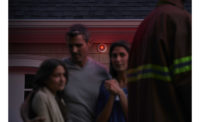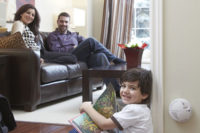CO Legislation |
| Many states have passed legislation requiring the installation of carbon monoxide (CO) detectors. The website of the National Conference of State Legislatures contains detailed, up-to-date information about this legislation on a state-by-state basis at the following site: www.ncsl.org/research/environment-and-natural-resources/carbon-monoxide-detectors-state-statutes.aspx. |
Today’s carbon monoxide (CO) and smoke detectors have a number of capabilities not available in the past. Advances in wireless and sounder technologies have made devices easier to install and more effective at alerting end users of alarm conditions. Devices that combine the two types of detectors into a single unit can simplify installation, while also meeting the latest National Fire Protection Association (NFPA) and other codes, which are being adopted by more and more authorities having jurisdiction (AHJs).
Commercial Smoke Detectors Go Wireless
Over the years the security industry has moved increasingly towards wireless, with more and more devices becoming available in wireless versions. Traditionally one of the most challenging devices to make in a wireless version, however, was the commercial smoke detector.
The big hurdle, according to Terry Shelton, director of technology design for Springfield, Mo.-based manufacturer Digital Monitoring Products, was a particular requirement of the UL864 standard aimed at ensuring that devices comply with the NFPA 72 National Fire Alarm & Signaling Code.
“If a smoke detector is within earshot of another smoke detector, you have to sync them so that you only hear one sound,” Shelton explains. And that has been a difficult requirement to meet using devices not wired to the control panel.
According to Shelton, though, DMP has found a way. While declining to provide details, citing competitive concerns, Shelton noted that the smoke detector has a built-in sounder and “the panel controls the sounder through the radio.”
As with other wireless devices, using a wireless smoke detector can save on installation time — and having a built-in sounder further simplifies installation by eliminating the need to install a separate sounding device, Shelton notes.
New Code Requirements
CO detection is increasingly becoming a requirement for fire installations. The latest versions of the International Building Code and the NFPA Life Safety Code require CO detection in certain commercial applications — primarily those involving sleeping areas. The latest version of the NFPA 72 code also gives CO alarms their own unique reporting and sounding requirements that are separate from those of fire alarms. (Smoke alarms use what is called “temporal 3” and CO alarms use “temporal 4” sound, explains Ted Milburn, vice president of marketing for Long Branch, N.J.-based equipment manufacturer Eaton.) And both CO and smoke alarm sounders must generate lower-frequency tones to enable them to better wake hearing or alcohol-impaired people, according to the latest codes.
Not all AHJs have adopted the latest codes, but as John Gallo, product manager for Vaughan, Ontario-based manufacturer Mircom explains, “in the last six to eight months it’s become more predominant.”
Manufacturers have redesigned their sounding devices — and where needed have also redesigned their control panels — to meet the new requirements. Increasingly manufacturers also are offering devices that combine smoke and CO detection, thereby enabling dealers to meet the new requirements with a single device.
“A lot of detector manufacturers have devices to detect both . . . and can send the correct information to the signaling device,” Milburn notes. “And on the notification side, they’re having multi-function devices that can do temporal 3 and temporal 4 at low frequencies.”
Combination devices minimize the installation time required to meet today’s requirements, Milburn notes. Dealers save “the labor of pulling new wire or conduit for a second device,” he explains.
Wayne Aho, senior product manager for Lansdale, Pa.-based equipment manufacturer Tyco Fire Protection Products cautions, however, that fire systems meeting the lower-frequency sounder requirements may draw more power in comparison with what dealers traditionally have installed. For larger installations, in particular, dealers should pay close attention to power calculations, he advises.
Moving Forward
Moving forward, smoke and CO detectors could see more changes, depending on whatever new code requirements standards bodies may implement.
The NFPA wants to require smoke detectors to better detect when polyurethane foam is burning and to provide better false alarm resistance to nuisance alarms caused from cooking — and burning — foods such as bacon, hamburger and toast, notes Jack McNamara, regional marketing manager for Fairport, N.Y.-based equipment manufacturer Bosch Security Systems.
As Aho explains, nuisance smoke alarms are not just a nuisance; they also can have potentially more serious consequences. “In residential installations, it’s too easy to for an individual to disable the smoke alarm (take the battery out, remove the unit altogether) .... If you’re experiencing a lot of nuisance alarm issues, that is a very dangerous situation,” he comments. “And in a commercial environment the danger is that people will simply ignore all fire alarms if nuisance alarms happen too frequently.”
Polyurethane foam is used in many types of furniture, and as McNamara explains, its smoke has smaller, darker particles than some other types of smoke, but “it’s close to the particle sizes we already look at.” UL is still in the process of determining the byproducts of burning food and how it will test whether smoke detectors meet the new standards involving burning food and polyurethane foam, McNamara notes. Accordingly, it has not yet set a deadline for manufacturers to implement these capabilities, he explains.
McNamara believes manufacturers’ solutions to meeting the new requirements may involve multi-criteria detectors that may combine CO, smoke, oxygen, carbon dioxide or other sensors.
“The single-technology detector might be going away because of this,” he predicts.
Another code change that is still under consideration is to expand the areas where CO detection is required, Gallo notes. “The Fire Protection Research Foundation did a report to determine if gas is capable of going through solid walls,” he says. The research seems to show that it is but researchers are looking at further studies to validate that finding, Gallo adds.
As CO detection is required as part of more and more installations, dealers are asking manufacturers to rethink how those products are designed, observes David Andersen, also a product manager for Mircom.
Because the sensing elements in CO detectors have to be replaced every several years, “we’re seeing demand to make a replaceable element,” Andersen explains, which would eliminate the need to replace the entire detector.
Whatever version of fire codes a local authority has adopted, security dealers will want to keep abreast of the latest requirements. And they will want to consider combination devices or wireless devices as potential labor-savers.
MORE ONLINE
SDM’s previous coverage on smoke and CO detection is available online. Check out related articles at the links below:
“Changes in the NFPA Fire Code are Driving a Thriving Retrofit Market”
“Commercial CO Detection Requirements on the Rise”






